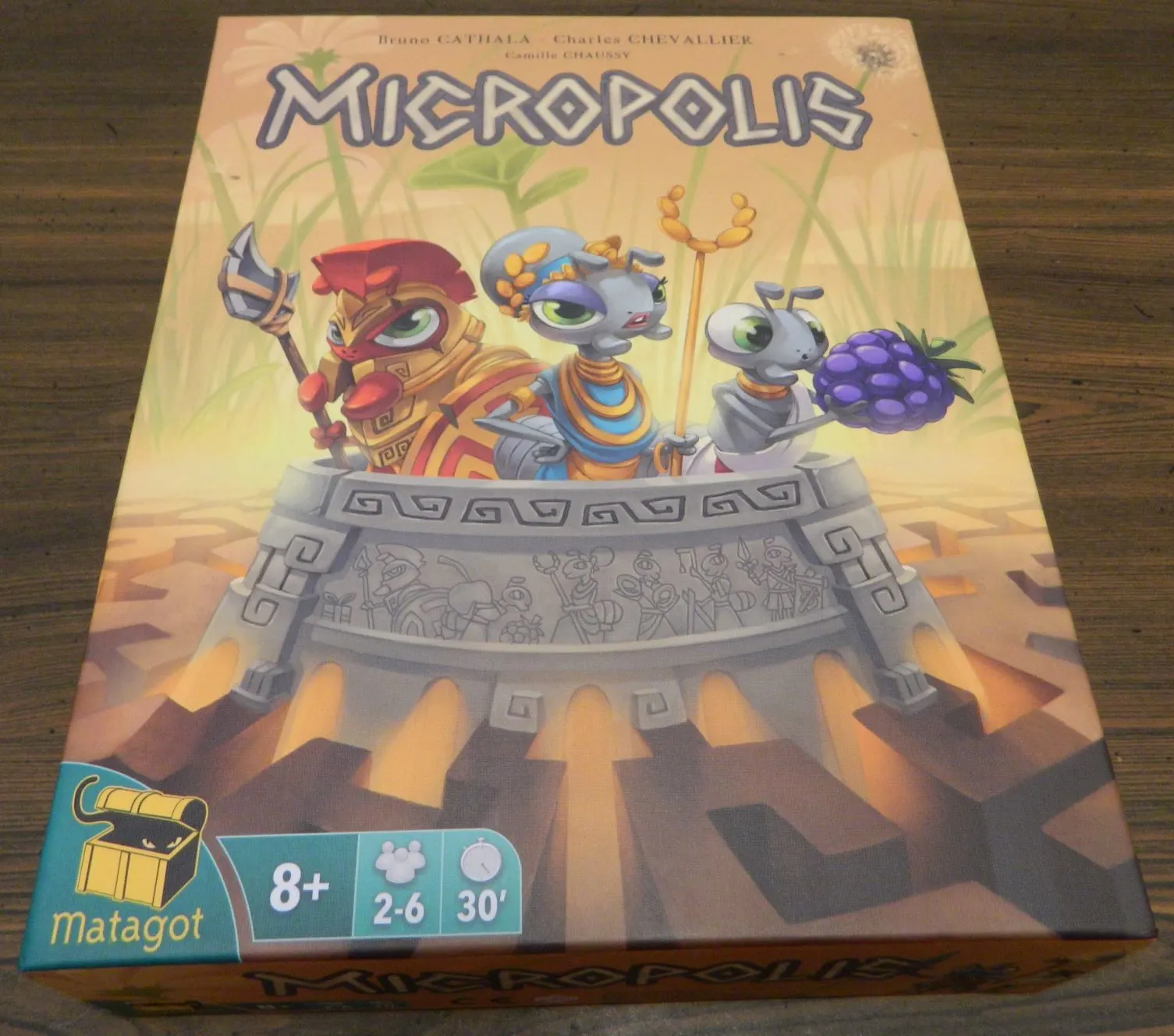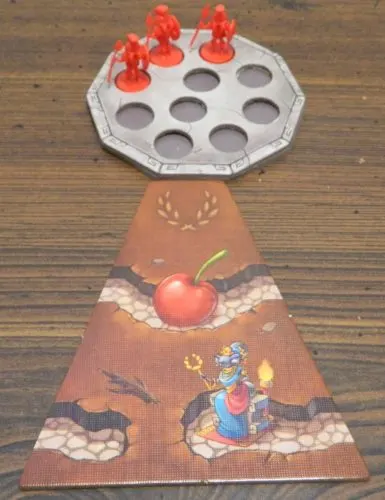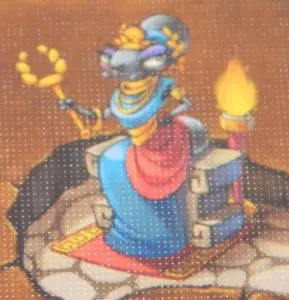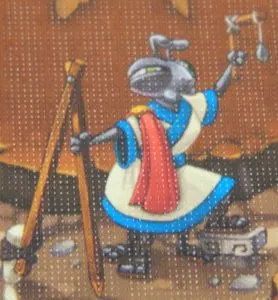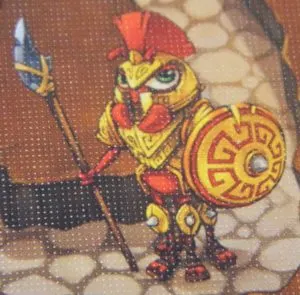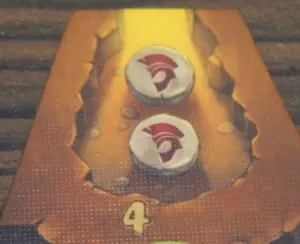Today I am taking a look at the 2018 game Micropolis. When I first saw the game on sale online I was intrigued for a couple reasons. First the theme of building an ant colony was intriguing. I have never played a game that has used a similar theme before, and it actually makes a lot of sense for a board game. The bigger reason that I was intrigued though was due to the game’s designers. I am interested in checking out any game created by Bruno Cathala (Five Tribes, Kingdomino) as most of the games he designs are excellent. The other designer Charles Chevallier has had a number of well designed games as well. Finally I am a sucker for tile placement games so Micropolis’ premise intrigued me as well. Micropolis may be a little too simple for some players, but it is a great tile placement game that the whole family can enjoy.
How to Play Micropolis
Setup
- Each player takes a Foundation tile and places it in front of themselves. They will then place five red Soldiers on it. These Soldiers form the player’s army.
- The rest of the Soldiers will be placed in the middle of the table.
- The two Architect tokens are also placed in the middle of the table.
- Shuffle the Anthill tiles and place them facedown to form a draw pile.
- Draw the first seven Anthill tiles and line them up on the table face up. The tile furthest from the draw pile is the first tile.
- The youngest player will start the game. They will take the Red Army token and place it in front of themselves to note that they are the current Military Leader.
Playing the Game
Micropolis is played over ten rounds. Each round consists of two steps.
- Choose a new Anthill tile.
- Expand your Anthill.
Starting with the Military Leader each of the players will take turns performing these two steps.
Choose A New Anthill Tile
The current player will look at all of the face up tiles on the table. They will choose one of the tiles that they would like to add to their Anthill.

Here are the seven tiles that are available to the players. The first tile (features the present) will be free for the players to take. Any present to the right of the first tile will cost one Soldier for each tile you pass through.
The first Anthill tile in the line (the furthest from the draw pile) is free. Every tile after the first tile costs one Soldier from the player’s army. The player will place one Soldier on each tile that they passed on.
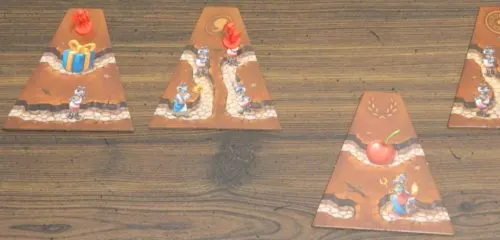
This player decided to take the third tile in the row. Because they chose this tile they will place a Soldier on the first two tiles.
If a player chooses a tile that has Soldiers on it, they will add those Soldiers to their army. A player’s army is limited to the number of spaces on their Foundation tile (ten Soldiers).
Expand the Anthill
In the first round players will attach their new tile to any space on their Foundation tile.
After the first tile, each additional tile must be placed next to one of the tiles already in the player’s anthill.
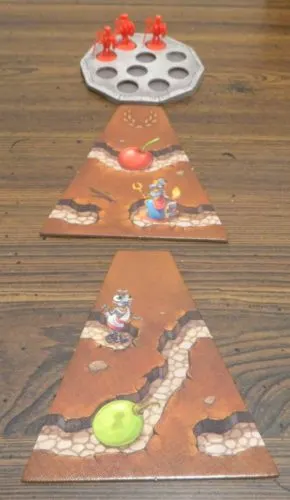
This player has acquired their second tile. They can choose to either place it to the left or right of the tile already attached to their Foundation tile.
If a player placed an Anthill tile that has a special effect (see the Special Anthill Tiles section below), they will take this special action now.
End of Round
After all of the players have taken an Anthill tile and added it to their anthill, the current round ends.
The players will count up the number of face up Anthill tiles left on the table. If there are more tiles than the number of players, another round is immediately played.
If there are less face up Anthill tiles than the number of players, you will reform the line of tiles. Slide all of the tiles away from the draw pile. You will then draw new tiles until there are seven tiles face up on the table.
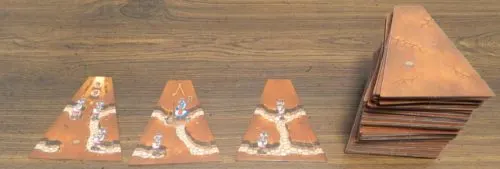
In this game there are four players. As there are only three tiles left, new tiles will be placed out on the table.
When new tiles are placed face up on the table, the players will check to see if there is a new Military Leader. Each player will count up the number of Soldiers in their army (the red Soldiers on your Foundation tile but not in barracks). If a player has a larger army than the current Military Leader, they will take the role of Military Leader. If there is a tie, the current Military Leader chooses which of the tied players will become the next Military Leader.
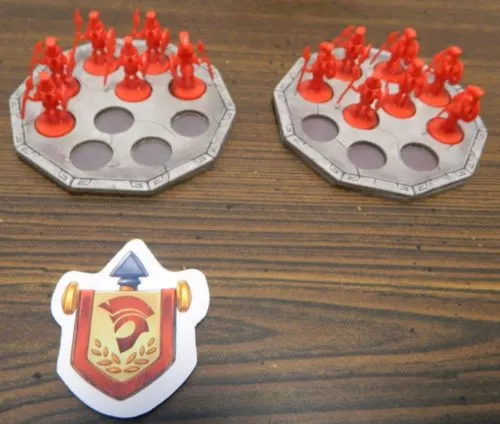
The current Military Leader has six Soldiers. The player on the right has seven soldiers so they will become the new Military Leader.
Special Anthill Tiles
The game has a number of tiles that feature special characters which give players a special ability when they are added to their anthill.
Queen: When a player adds a queen to their anthill they have the opportunity to score points for each tile in the Gallery that the queen is placed in. This only happens if there isn’t another queen in the same Gallery. See below for more information.
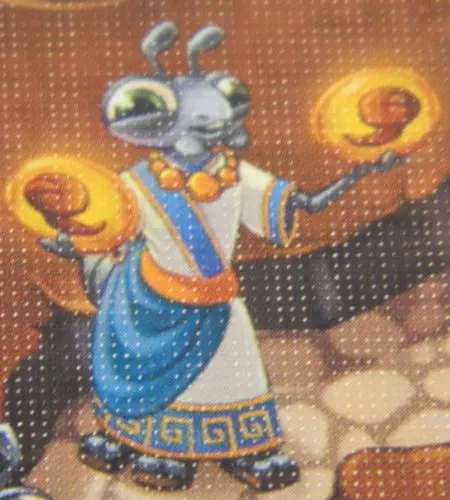
This nurse shows two eggs so the player who adds the tile to their anthill will get to take two Soldiers.
Nurse: Each nurse will be pictured with a number of eggs in their hands. The player will add a number of Soldiers to their Foundation tile equal to the number of eggs pictured. A player can never go over ten Soldiers on their Foundation tile.
Architect: When a player adds an architect to their anthill they will take one of the Architect tokens. On any future turn the player may return this token to the middle of the table to take any of the face up tiles without having to give up Soldiers.

In a previous round the current player acquired an architect token. In this round they used the token to take the last tile without having to use any Soldiers.
Recruiting Sergeant: The player that is currently the Military Leader will have to discard one of the Soldiers from their Foundation tile. Then the player who added the recruiting sergeant will add one Soldier to their Foundation tile.
Sentry: When a player adds a sentry to their anthill they have the opportunity to move Soldiers around their anthill. The player can move Soldiers between their Foundation tile and any barracks. When moving ants to or from barracks, they must either be completely full or empty as partially filled barracks are not allowed.
Barracks: When a barracks is added to a player’s anthill they have the opportunity to immediately move Soldiers from their Foundation tile to the barracks. If you choose to add Soldiers to the barracks though you must fill all of the spaces. Soldiers placed in barracks are safe from the recruiting sergeant and will score you points at the end of the game. You must make this decision right after placing the tile. Otherwise you will have to place a sentry to move Soldiers to the barracks later in the game.
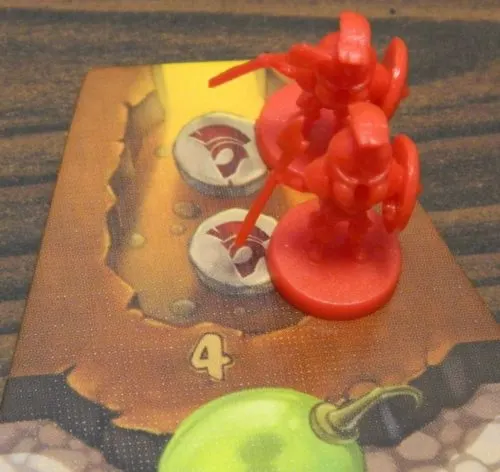
When this player acquired the barracks tile they chose to add two of their Soldiers to it. They will score four points at the end of the game.
End of Game
The game ends when all of the players have finished their anthill (ten rounds). The players will then add up their victory points to determine the winner.
For several of these scoring categories players will score points for “Galleries”. A Gallery consists of all of the paths that are connected to one another without a break.
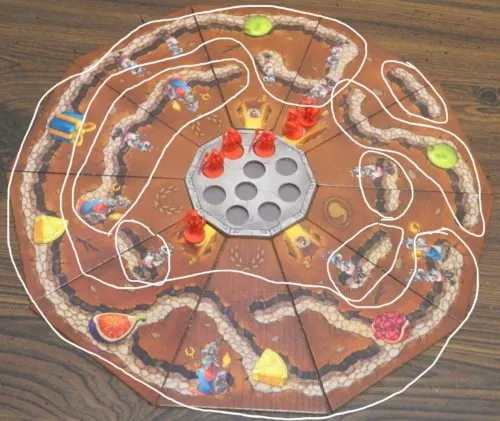
Each section of this anthill that is circled is a different Gallery. These Galleries will be used to determine points for several of the different scoring categories.
Players will first score points for their population. A player’s population is equal to all of the ants that are printed on the tiles that form their Anthill. Each player will score a point for each ant in their anthill.
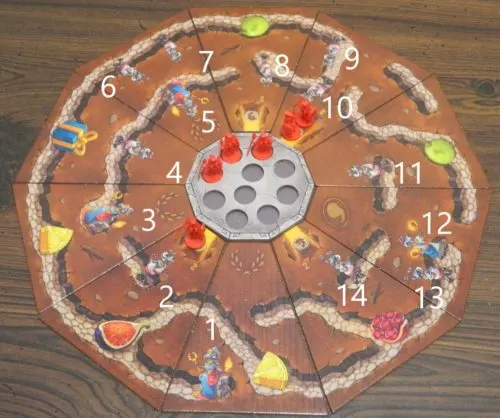
In this picture I have highlighted all of the ants in this player’s anthill. As they have fourteen ants in their anthill, they will score fourteen points.
Each player will then count up the ants in each of their Galleries. The player that has the most ants in one Gallery will score five points.
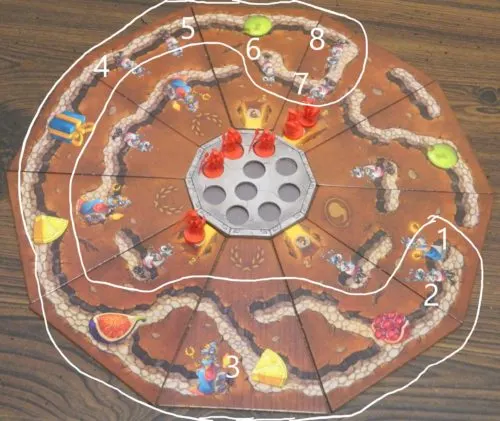
I have circled this player’s Gallery that features the most ants. This player had eight ants in their largest Gallery. If no other players had more than eight ants in a Gallery, this player will score five points.
Next the players will score points for the number of different types of fruit in each of their Galleries. Presents can count as any type of fruit. If you have two or more presents in the same Gallery, each present can count as a different type of fruit.
- One Fruit Type: 2 points
- Two Fruit Types: 5 points
- Three Fruit Types: 10 points
- Four Fruit Types: 15 points
- Five Fruit Types: 20 points
- Six Fruit Types: 25 points
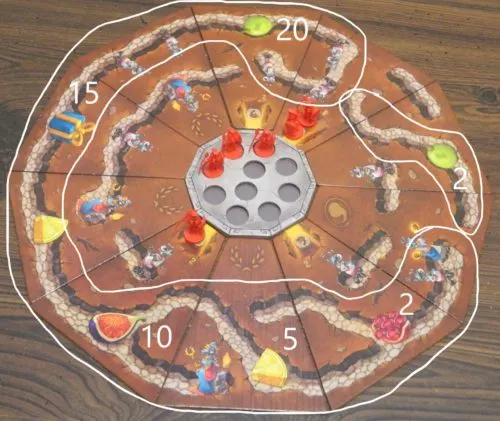
This player has created two Galleries which contain fruit. The smaller Gallery only features one fruit so it will score two points. The larger gallery will score 20 points as it features five different fruits. The second lemon will not score any points as you only count each unique type of fruit once. The present will act as either of the other two fruits that aren’t in the Gallery.
The players will then look at their Galleries to find ones that feature only one queen. The player will score one point for each tile that the Gallery stretches over. If a Gallery has two or more queens, the player will score no points for that Gallery. If a player has multiple Galleries that fit this criteria, they will score each separately.
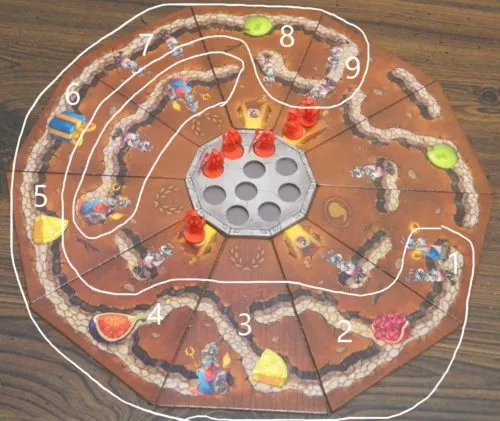
This player ended up creating two different Galleries that feature queens. One of the Galleries features two queens so it won’t score any points. The other Gallery only features one queen and it extends through nine tiles. This player will score nine points for the Gallery.
Each player will count up the number of Soldiers that they have in their army (Soldiers on your Foundation tile but not barracks). The player with the largest army will score five points.

Here are the armies of the four players from the game. The players had the following number of Soldiers in their army: eight, six, four, and three. The player with eight soldiers will score five points.
Finally players will score points for the Soldiers that they have in a barracks. They will score points based on the size of the barracks.
- One Soldier: 2 points
- Two Soldiers: 4 points
- Three Soldiers: 7 points
- Four Soldiers: 10 points
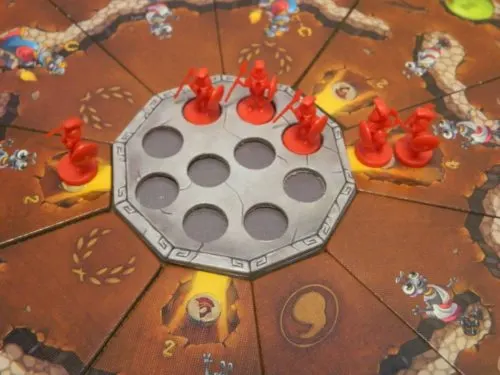
This player has filled two of the barracks during the game. The barracks that has one Soldier in it will be worth two points. The barracks that has two Soldiers will be worth four points.
The players will compare their final scores. The player with the most points will win the game. If there is a tie, the tied player with the largest army (Foundation tile but not barracks) will win the game. If there is still a tie, the tied players will share the victory.
Expert Mode
If players want a more challenging game they can choose to play the expert game. This variant only supports two or three players. In this mode each player will form two anthills during the game. Most of the rules are the same as the normal game except for the differences mentioned below.
Setup
- Each player takes two Foundation tiles and places five Soldiers on each of them.
- The first Military Leader chooses which of their two anthills that they will place the Red Army token on.
Playing the Game
Players will play two rounds in a row before new tiles are placed face up on the table.
When a player chooses to take a tile other than the first, the Soldiers used to acquire it must come from the anthill that the tile will be placed in.
Players do not have to build both of their anthills at the same pace. They can focus on one anthill and then move onto the other later in the game.
When determining the new Military Leader, each anthill is treated as its own as players don’t combine the Soldiers from both anthills. If there is a tie between the current Military Leader’s anthill and another player’s anthill, they must give the role to the other player.
End of Game
Each anthill is scored separately. The players will then add both totals together to get the player’s total score. The player with the most total points wins the game. If there is a tie, the tied player with the largest army wins the game. If it is still a tie, the tied players share the victory.
My Thoughts on Micropolis
At its core Micropolis is a tile laying game. Players will take turns choosing a tile and placing it into their anthill. The objective is to acquire tiles that work well with the other tiles that are already in your anthill. In most cases this involves finding tiles with paths that can be connected to the paths already present in your anthill. You can end paths without any punishment, but for scoring purposes you usually will benefit from creating as large of galleries as possible as you will score more points.
Most of the tile laying mechanics aren’t particularly new as there are many other games that use the same type of mechanics. One area where the game kind of differentiates itself though is from the shape of the tiles. Most games utilize squares or rectangles which you use to create a larger rectangle/square. In Micropolis you will end up making a decagon (ten sided shape). Because of this each tile that you place will have to be placed either to the left or right of the group of tiles that you have already placed. Thus you need to plan ahead a little as each tile you place will limit your options in the future. The two ends of your anthill will eventually merge with the last tile that you place. Therefore you need to plan ahead in order to make sure this last tile doesn’t mess with your other scoring plans. The galleries you end up creating will play a large role in how many points that you will score at the end of the game.
Outside of building a decagon instead of a square/rectangle, many of the tile placement mechanics in Micropolis are similar to many other games from the genre. The game doesn’t particularly revolutionize the genre as I can’t think of a mechanic from the game that I haven’t seen utilized in other games. This is not necessarily a bad thing as the game capitalizes on the most enjoyable elements of the genre. It is quite satisfying building your anthill. This is one area where the game’s theme really pulls through. It honestly feels like you are building an anthill for your colony of ants. The game could have probably used a number of other themes that would have worked with the gameplay, but the ant theme works really well.
Other than laying down tiles in order to create your anthill, the other main mechanic in the game comes from how you acquire your tiles in the first place. All of the tiles that you can choose from are face up on the table so you don’t have to worry about randomly drawing a tile that doesn’t work with your current plans. The first tile in the row is always free. Sometimes this tile will be perfect where it helps you and you didn’t have to pay anything for it. If that tile either hurts you or there are better options available though, you then have to consider paying Soldiers in order to take one of the other tiles. Each tile you move from the first tile will cost you one Soldier. So if you want one of the tiles that are far from the first tile it might become costly.
Paying for tiles other than the first in the row is a really interesting mechanic. The Soldiers you pay to take these tiles serve a number of purposes in the game. First they are used to determine who gets first choice when new tiles go out. If you use them to get a tile, you likely will be left with the tiles that the other players didn’t want. The Soldiers can also score you points at the end of the game through barracks and having more than any other player. Finally if you ever use up all of your Soldiers you will get stuck with the first tile even if it doesn’t work at all with the rest of your anthill. At times it is worth it to get the perfect tile for your anthill even if it costs you most of your Soldiers. You won’t always be able to get the tiles that you want though so you have to pick and choose when you use your Soldiers. This forces you to make some tough decisions.
I had pretty high expectations for Micropolis and for the most part it met them. I am a sucker for a good tile placement game, and Micropolis does a good job capitalizing on what I enjoy most about the genre. I think a lot of this can be attributed to the fact that the game does a great job finding the right balance. Anyone who has any experience with the tile placement genre should be able to pick up the game really quickly. It may take a little time for some players to fully understand all of the different ways of scoring points, but otherwise the game is quite easy to play. You just pick a tile and place it into your anthill. The game has a recommended age of 8+ which seems about right. Because of Micropolis’ simplicity I can see it working really well as a family game as well as a game to play with those that generally don’t play a lot of board games.
In addition to being easy enough for most people to be able to play, Micropolis’s simplicity also leads to the game playing pretty quickly. The length will somewhat depend on the number of players, but I can’t see most games taking much longer than 20-30 minutes. I think this is due to a couple reasons. First the game has a definite length as each game lasts 10 rounds. Each player’s turn only consists of two actions which are usually pretty straightforward. You may occasionally have a decision to make which will take a little time, but analysis paralysis shouldn’t pop up much because the best decisions are usually pretty obvious. Even when they aren’t there isn’t too much to consider so you never have too much to analyze. This shorter length makes Micropolis a great filler game for when you don’t have much time, or you want a quick break from deeper games.
Even though the game is quite simple to play, it still has more strategy than you would initially expect. The game’s strategy mostly comes from the various ways of scoring points in the game. In total you can score points from six different sources at the end of the game. I appreciate having so many different ways of scoring points as it gives players different options so they can adapt to the available tile options and their current anthill layout. Most of the different scoring options benefit from players creating large galleries so you want to try to create long interconnected paths in your anthill. There is a caveat though as you don’t want to connect two queens as you will then lose all of the associated points. I haven’t played the game enough to know if one particular strategy is better than others, but I always appreciate when a game gives players options.
While Micropolis has more strategy than you would initially expect, it may be a little too light for some players. As the game was built as more of a family game, it likely won’t appeal to people who enjoy games that involve a lot of deep strategy. There are tile placement games out there that require quite a bit more strategic decision making than Micropolis. Having a good strategy in the game will certainly help, but there are other factors in play as well. Usually your best option is pretty obvious so you won’t have to come up with clever strategies out of thin air in order to win. I personally see the game’s accessibility as an asset, but some players will likely see it as a detriment to the game.
One of the major contributors to the game not being super strategic is the fact that the game relies on a decent amount of luck. This luck mostly comes from what tiles are revealed and which are still available when it is your turn. You have some control over turn order as you can keep Soldiers in order to make yourself Military Leader. If another player is hoarding Soldiers though they could end up going first several turns in a row. As for what tiles are available, it can help or hurt you in a couple of ways. First you need to hope that there are tiles that work with your current anthill layout. For example if you currently have a large Gallery you need to hope for tiles that will continue your current path instead of cutting it off. In addition some tiles are more valuable than others. Some include special characters or fruit that can help you, while others are mostly just paths. Finally the location of the tiles matters as well. There could be a tile that you really want, but it could be far from the first tile. This tile could be perfect for you, but it will either cost a lot of Soldiers or you might not even be able to afford it. Basically if a player has tiles available to them that work well with their anthill, have special characters or fruit, and are close to the first tile; they will have a much better chance of winning a game than someone who has the complete opposite. Your strategy will play a role in how well you do, but if luck is not on your side you are likely going to have trouble winning the game.
As for Micropolis’ components I thought they were quite good. Most of the components are made out of cardboard, but they are quite thick where they should last for a long time. I thought the game’s artwork was quite good as the game anthropomorphizes the ants. The artwork also does a good job reducing the reliance on reading text as the design and icons do a good job explaining things to the players. I also have to applaud the number of tiles as the game has plenty. The game supports up to six players which is uncommon for a tile placement game. You can also play with up to three players where each player builds two anthills. I thought the little plastic Soldiers were nice as well. Honestly the only complaint I had with the components is that the game probably could have used reference cards that outlined how you score points. For your first game you may have to reference the rules a number of times because there aren’t any reference cards.
Should You Buy Micropolis?
Based on the theme, genre, and designers I had pretty high expectations for Micropolis. The game met my expectations for the most part. At its core the game is pretty similar to your typical tile placement game. You basically just pick tiles and place them in your anthill in order to score points. These mechanics might not be the most original, but they do a good job capitalizing on the most enjoyable aspects of tile placement games. Adding in the mechanics where you have to pay for certain tiles adds some decision making into what tiles you ultimately choose to add to your anthill. Micropolis is mostly successful because it finds the perfect balance between accessibility and strategy. The game is really easy to play where the whole family can enjoy it. There is enough strategy to the game though due to the different ways of scoring points which should keep players entertained. Some players may wish the game was a little deeper though as it likely won’t appeal to people who generally like games with a lot of strategy. The game also relies on a decent amount of luck when it comes to what tiles are available to you. Micropolis is still a good game that I really enjoyed playing.
My recommendation comes down to your thoughts on the premise and tile placement games in general. If you don’t usually like tile placement games or generally prefer deeper games, Micropolis probably won’t be for you. Those that like more family friendly tile placement games though will likely really enjoy Micropolis, and should really consider picking it up.
Buy Micropolis online: Amazon, eBay
. Any purchases made through these links (including other products) help keep Geeky Hobbies running. Thank you for your support.

